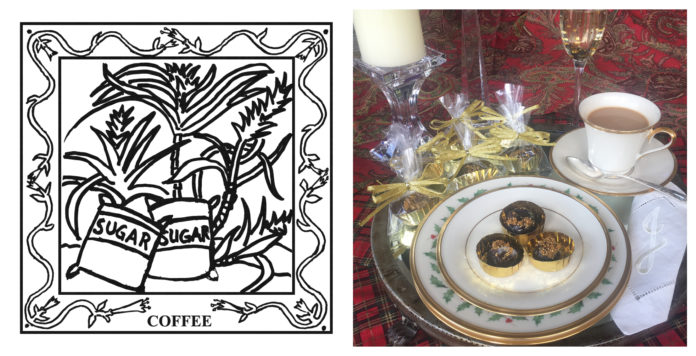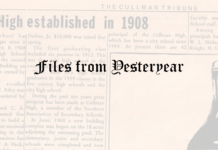
The Cullman Tribune is celebrating the Alabama Bicentennial (1819-2019) with statewide field reporting by Alabama Master Gardener/Botanical Artist Ben Johnson South. This year-long feature, “The 67-County Alabama Garden Party,” will spotlight different counties each week. Each county will get its own “quilt block,” along with a historical profile, and we’ll share a recipe specific to the area. At the end of the year, all 67 counties will be put in a book to commemorate the Bicentennial.
Coffee County
“The Greatest Alabama Showman,” James Hatcher, was born in Enterprise way down south in Coffee County. Actually, this county has given us a sugar bowl of sweet-talking showmen. The charismatic, two-time governor of Alabama and mesmerizing storyteller, James E. “Big Jim” Folsom, was born near Elba. The nationally renowned, motivational rabble rouser Zig Ziglar was born here. Even the popular, peripatetic “Dancing Ghost,” Grancer Harrison, made immortal in Kathryn Tucker Windham’s “13 Alabama Ghosts and Jeffrey,” hailed from Coffee County.
Sugar is my theory for why Coffee County birthed some of “Alabama’s Greatest Showmen.” More specifically, that super-stimulated “brain buzz” commonly known as a “sugar high.” This is the rush hyperactive sugarbabies of all ages get when they sop a biscuit through sorghum then eat a mouthful of sugar-soaked candy and then have sugar-coated cookies and then sugar-sprinkled something and then sugar-covered something else and then wash it down with sweet tea so sugary you can stand a spoon up in it. And then and then and then, that’s my theory and I’m sticking to it like an all-day sucker on a teddy bear.
LA, Lower Alabama, is considered a sub-tropical area and the HEAT + HUMIDITY make Coffee County a viable area to grow sugarcane. Most Alabama counties grow sorghum, but it’s only the southernmost with milder winters where sugarcane can thrive. Sugarcane (Saccharum officinarum) and sorghum (Sorghum bicolor) are “sweet grasses” and both can be cultivated in Coffee County. Historically, that has meant sugar is more abundant down in this part of the state.
The Coffee County gent known as “The Greatest Alabama Showman,” James Hatcher, was a cultured, Birmingham-Southern College graduate, but he was as tirelessly adept at creating and promoting theater, ballet, music and even the Miss Alabama Pageant as any carnival barker. He was the founding director of both Town and Gown Theatre at the University of Alabama at Birmingham (now Virginia Samford Theatre) and Summerfest (now Red Mountain Theatre Company). Hatcher was a founding member of the Alabama Council on The Arts and helped launch the Alabama School of Fine Arts (Birmingham).
Hatch would have loved this tale and could have conjured it into a sugar sweet, children’s theatrical:
“THE STORY OF JACK, THE COFFEE COUNTY SUGARCANE FARMER”
Once upon a time, long before Coffee County was established, which was way back in 1841, the pioneers in this remote part of Alabama lived in small farming settlements next to the forests. These early settlers, way inland from major riverways, were mostly self-sufficient farm families. They survived by trading goods and services with other farmers in the area. A good fellow named Jack was a sugarcane farmer who lived near present day New Brockton when something horrible happened.
One morning, a neighboring cattle farmer woke to find his cows slaughtered and eaten. Amid the carnage, the cattleman found giant footprints that led into the forest.
The next night, a horrible ruckus came from a nearby chicken farm. Searching by torchlight, the farmer found his coops empty, all his chickens gone, and giant footprints led again to the forest.
The next day all the frightened settlers met at the village church. They came to call the monster, Midicrin, because the attacks occurred in the middle of the community.
That night, Jack camped out in his sugarcane field. Around midnight he saw a terrible creature as tall as the church steeple roaming toward him.
Jack watched as the giant Midicrin grabbed stalks of sugarcane and chewed them. As he watched, the Midicrin suddenly bent over and spewed out the chewed sugarcane. Then, the Midicrin stomped back into the forest. Jack concluded the monster was sugar-intolerant, which could have accounted for his sour disposition.
This insight gave Jack an idea and he called everyone in the settlement together. One of Jack’s neighbors raised geese, ducks and loons. Jack proposed feeding the sugarcane-loving loons to set a trap for the monster.
Sure enough, the Midicrin returned. He was hungrier than ever because he had hurled his sugary dinner the night before.
The monster started eating the cane-stuffed loons. Then, the “sugar rush” caused him to be so swoony-headed he spit out the loons he had swallowed, and he fell backward. The angry mob then attacked the Midicrin monster with pitchforks until he was most-assuredly dead.
Then, everyone in the community danced and sang.
(The moral of the story, as Jack explained, was: A loon full of sugar helps the Midicrin go down.)
Besides sugarcane and sorghum, there are lots of other positive and pleasurable PLANTS + PEOPLE things for showmen and showwomen in Coffee County to share stories about, including these:
*ENTERPRISE DOWNTOWN FARMERS MARKET- 525 North Main St., Enterprise, AL 36330; Tuesdays, Thursdays and Saturdays, 7-11 a.m. (OPEN YEAR-ROUND)
*COFFEE COUNTY FARMSTANDS- Bobby Helms (Enterprise), Joe Powell (Enterprise), M. Howell (Kinson), Roy Johnson (Samson)
*COFFEE COUNTY U-PICK FARMS- Leaky Brook Farm (Elba) call for availability, 334-248-9087; Robert Parker Farm (Coffee Springs) call for availability, 334-393-9139; Country Best Farm (Enterprise); The Pea Patch (Enterprise); Archie Farms (Kinston)
*COFFEE COUNTY PLANT ADVICE/EDUCATION- Alabama Cooperative Extension System office, 5 County Complex, 1055 East McKinnon St., New Brockton, AL 36351, 334-894-5596
*COFFEE COUNTY FOOD/FARM FESTIVALS- Boll Weevil Festival (October in Enterprise), Elba Pumpkins On The Square (October), Enterprise Pumpkins on The Square Festival (late October), Elba Chamber of Commerce Watermelon Day (early summer), Enterprise Farmers Market Watermelon Day (summer), Enterprise Farmers Market Peanut Day (late summer), Taste of Coffee County Festival (Enterprise), Rockin’ The River (Elba)
*COFFEE COUNTY PLANT-CENTRIC SHOPS- Stinson’s Christmas Tree Farm (Jack, AL), Winna Gayle Gardens (New Brockton), Sue’s Nursery (Enterprise), Weevil Nut Company (Enterprise)
*COFFEE COUNTY FARM-TO-FORK EATERIES- Corks and Cattle (Enterprise), The Rawls (Enterprise); Mimi K’s Down on Main (Enterprise)
*COFFEE COUNTY PLANT-CENTRIC GIFT SHOPS- The Olive Fruit (Enterprise), Boll Weevil Soap Company (Enterprise)
*BEST PLACES IN COFFEE COUNTY FOR LANDSCAPE PHOTOGRAPHERS/PAINTERS- The Boll Weevil Monument (Downtown Enterprise), Pea River (Elba), Veterans Memorial Park (Elba), Coffee County Lake (Elba), Henderson Park (Enterprise)
*PLANTING AN IDEA- Create a grass-carpeted amphitheater, outdoor performance space in Coffee County. There are still legions of devoted James Hatcher theater fans who would like to entertain naming rights for such a venue. This southern part of Alabama doesn’t have an abundance of outdoor theater. I’m thinking of an annual show like “The Miracle Worker” in Tuscumbia. Perhaps a playwright-in-residence could pen something site-specific. Gifted Alabama playwright Hubert Grissom was recently awarded top prize at Jacksonville State University for a new play about Coffee County native son Gov. “Big Jim” Folsom. This play could be performed out-of-doors as a fundraiser for a landscaped, terraced space. (This doesn’t have to be epic in scale. I’m thinking of something like the earthwork amphitheater at Great Fosters in England. Imagine sloping, mown grass terraces, perhaps surrounded by waving sweet grasses of sugarcane and sorghum.)
Y’ALL COME to Coffee County on your 67-County Alabama Garden Party tour! How sweet it is!
Coffee County Southern Sugar Cane Candied Chestnuts (~ 60 pieces)
At first, Ben’s mention of candied chestnuts sounded completely alien to this Southern girl, as I know plenty about sugared things but not much about chestnuts. Not much, except for those “roasting on an open fire” in the familiar Christmas song (reportedly the first Christmas standard introduced by a black American, beloved Alabama-born icon, Nat King Cole). Fast forward through a little research – candied chestnuts, or Marrons Glacé, are a French, Christmas tradition, much like fudge and divinity in the South. Developed when European traders first introduced sugar, they rose to popularity in the 17th century as decadent treats in the Versailles Court of Louis XIV. This traditional recipe is adapted with Southern-grown cane sugar and chestnuts that I purchased, online, already roasted and peeled- an ease certainly not imagined centuries ago. Letting the nuts absorb the cane sugar takes time, 5-6 days, but hands-on effort is minimal and very easy. The reward is uniquely luscious and worth the effort. Another plus is that for six days, your home is scented, deliciously, like vanilla and cane sugar! Try these small, sweet delicacies for a new Christmas tradition and distinctive holiday gifts.
Ingredients:
- ~ 20 oz. chestnuts, whole, roasted and peeled, preferably organic (four 5.2 oz.-pouches purchased online)
- 20 oz. raw cane sugar, granulated and preferably organic
- 1 2/3 cups water
- 1 tsp. pure vanilla extract
Instructions:
Tip – study soak times and plan to start when you will be home (and awake) for the next steps.
- In a medium saucepan, bring the water, cane sugar and vanilla to a boil, stirring continuously, and cook for about 5 more minutes, stirring frequently.
- Add the chestnuts to the boiling syrup and stir until the mixture returns to a boil. Continue cooking for ~ 10 more minutes, stirring occasionally, but gently, to not tear up the nuts.
- Take off the heat and pour the whole mixture into a heat resistant, non-metallic bowl. Cover loosely with a kitchen or paper towel and set in an out-of-the-way place as the chestnuts start soaking up the sugar cane syrup; for this first time, soak them for 12–18 hours.
- Pour the whole mixture back into a saucepan and boil for 2 minutes, stirring gently. Pour back into the soaking bowl, loosely cover again and let stand for 18-24 hours. Repeat this 2-minute boil and soak process 4 more times until the nuts have absorbed most of the syrup.
- After the last boil/soak cycle, drain in a colander and discard residual liquid. Preheat oven to 250F and line a cookie sheet with parchment paper. Place the drained nuts in a single layer on the sheet, put into the oven and immediately turn the oven off. Leave in the oven for ~ 45 minutes, up to an hour, until they are firm, and the surfaces are dry – not still tacky.
- Remove the pan to a cooling rack. Once cool, place the candied chestnuts into foil candy cups or treat bags and store in a tin or other airtight container.
- For a “prettier” presentation, after cooled, dip just the top of each into a very small amount of cooking spray (sprayed onto a plate) and then into a plate of gold, coarse, edible glitter/sprinkles for a golden “crown” and a little crunch.
- Enjoy and share this unique French delicacy, adapted with Southern cane sugar and the convenience of already peeled chestnuts.
Also, check out Alabama Bicentennial: 200 ways to save Alabama for the next 200 years.
Copyright 2019 Humble Roots, LLC. All Rights Reserved.
























